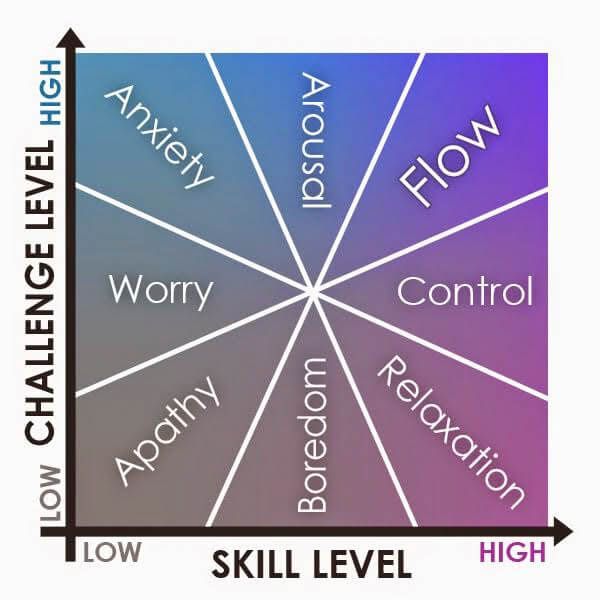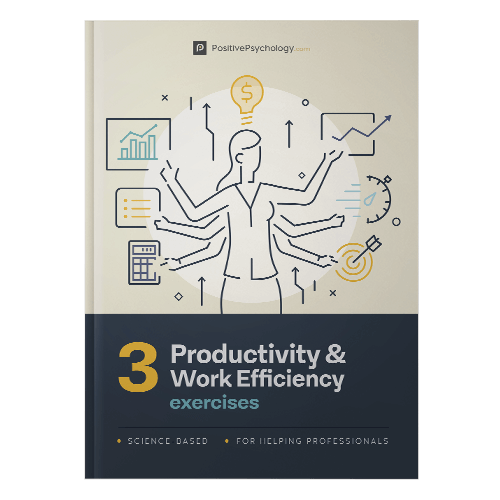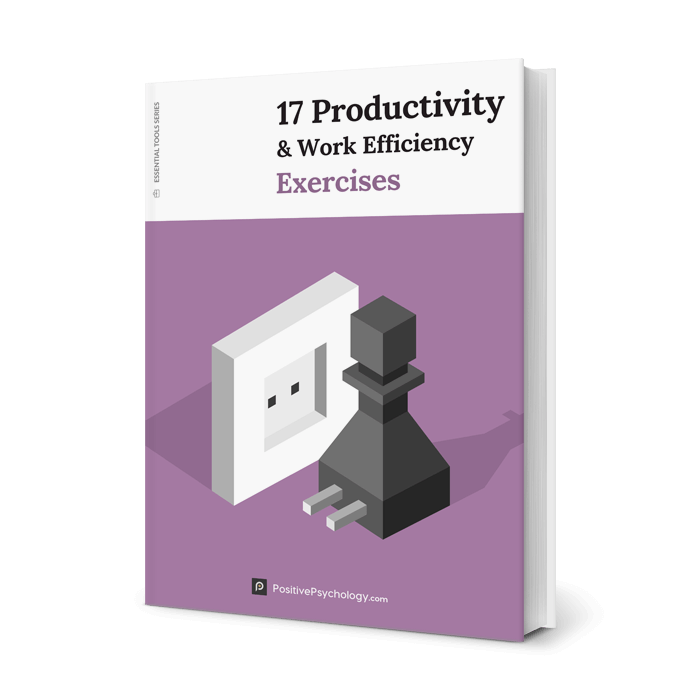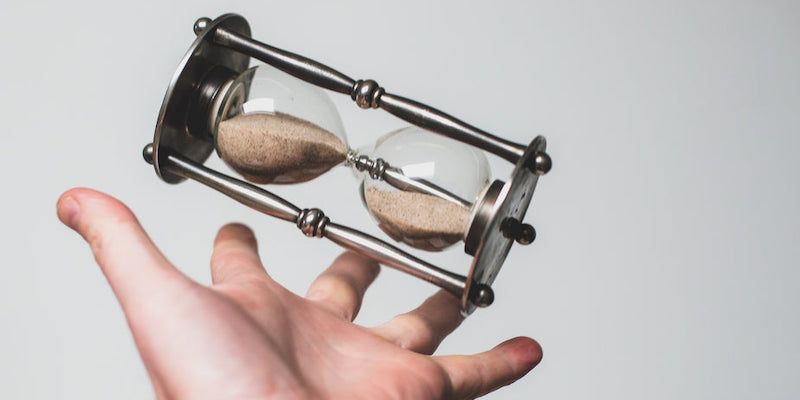What Is Flow in Positive Psychology? (Incl. 10+ Activities)
 Have you ever been completely and utterly immersed in a task?
Have you ever been completely and utterly immersed in a task?
Oblivious to the outside world, focused only on your own progress and what’s going on right here and now?
Maybe you’ve been doing something you love, like playing music or a certain sport, before realizing that time has totally passed you by?
If you’ve answered yes to any of these questions, it’s likely that you’ve been experiencing a state of Flow.
Flow is one of life’s highly enjoyable states of being, wrapping us entirely in the present, and helping us be more creative, productive, and happy. Here you’ll find some information on the background of the Flow concept, its significant role in positivity, and its implications both for individuals and groups.
We’ll look at the different ways of how Flow can be measured, as well as some activities and ways to trigger your own Flow state.
Before you continue, we thought you might like to download our three Productivity Exercises for free. These detailed, science-based exercises will help you or your clients become more productive and efficient.
This Article Contains:
- What is the Concept and Meaning of Flow?
- The Theory and Psychology of Flow
- Flow and Positive Psychology
- The Work of Mihaly Csikszentmihalyi
- Flow: The Psychology of Optimal Experience (Book)
- The Flow State Chart and Scale
- A Look at Flow and Happiness
- The Research on Flow Experience
- Brain Waves and Neuroscience
- How to Enter a Flow State of Mind
- 10+ Activities to Help Attain a Flow State
- 17 Flow State Triggers to Induce Flow
- Meditation and Flow
- The Importance of Flow in the Workplace
- A Look at Flow in Sports and Training
- 3 Recommended YouTube Videos
- 4 Book Recommendations
- A Take-Home Message
- References
What is the Concept and Meaning of Flow?
Psychological Flow captures the positive mental state of being completely absorbed, focused, and involved in your activities at a certain point in time, as well as deriving enjoyment from being engaged in that activity. Perhaps the Flow state, colloquially termed being ‘in the zone’, is best described by one of the participants interviewed in the earliest stages of ‘Flow research’ (Csikszentmihalyi and Csikszentmihalyi, 1988: 195):
“My mind isn’t wandering. I am not thinking of something else. I am totally involved in what I am doing. My body feels good. I don’t seem to hear anything. The world seems to be cut off from me. I am less aware of myself and my problems.”
Mihaly Csikszentmihalyi, the positive psychologist credited with having popularized the concept of Flow, offered another definition for the mental state of being ‘in Flow’ in his interview with Wired magazine:
“…being completely involved in an activity for its own sake. The ego falls away. Time flies. Every action, movement, and thought follows inevitably from the previous one, like playing jazz. Your whole being is involved, and you’re using your skills to the utmost.”
If it’s something that sounds akin to other mental states, like those that meditation or yoga can facilitate, it may be interesting to note that similar ideas feature in Buddhist, Taoist, and Hindu literature. To put it succinctly, Flow can be thought of as (Csikszentmihalyi and Csikszentmihalyi, 1988: 36):
“the holistic sensation that people feel when they act with total involvement.”
The Theory and Psychology of Flow
Flow theory became of interest to positive psychology researchers Jacob Getzels and Mihaly Csikszentmihalyi when they were studying the creative process during the ‘60s (Getzels & Csikszentmihalyi, 1976).
Watching an artist at work, Csikszentmihalyi became intrigued by their single-minded, unique focus, and persistence to continue with the painting, despite any discomfort, tiredness, or hunger. On finishing the painting, however, the artist entirely ceased showing any interest in the completed work.
Csikszentmihalyi (1975) then took his research into other fields, looking at the circumstances and subjective nature of this enjoyment-related phenomenon in dancers and chess players, to name a few. It became apparent that the Flow state was brought about by at least two key things: goals and feedback.
First, an optimal Flow state was created when people tackled challenges that they perceived to be at just the right level of ‘stretch’ for their skill sets. In other words, neither too tough nor too easy as to be boring.
Second, they had unambiguous short-term goals and received instant feedback on their progress. This latter condition made them aware of their progress and let them change their goal-oriented actions accordingly.
Throughout it all, people described being ‘in Flow’ as a highly pleasurable experience. They enjoyed being in control of the task-related largely to the ongoing feedback they received. Ultimately, they found whatever they were doing to be highly self-rewarding (Stavrou et al., 2015).
Flow and Positive Psychology
Naturally, the next point of interest for positive psychologists became how Flow could be created, controlled, and understood in relation to other aspects of the self that allow us to flourish.
Flow became fascinating to positive psychologists already looking at performance, goal orientation, creativity, attention, and of course, emotions. Only a little after that, the concept grew more popular with researchers such as Deci and Ryan (1985), who were interested in flow within intrinsic motivation.
Most importantly, it’s been considered a huge part of improving our human experience for its role in living a meaningful life (Seligman, 2002: 249). A meaningful life in which we use our virtues and strengths for ‘something much larger’ than we are, where we spend less time worrying about the inauthentic and the mundane. Where we are less annoyed by the boredom of the too-easy, or overwhelmed by the frustration of the too-challenging.
Understanding how to enter the flow state, and maintain it, therefore, is seen as a great way to enjoy the activities we get engaged in.
The Work of Mihaly Csikszentmihalyi
Csikszentmihalyi often described Flow as an autotelic experience. An autotelic experience quite simply describes an activity that’s pleasant, enjoyable, and intrinsically motivating.
It’s perhaps a little easier to understand how Csikszentmihalyi’s seminal work had impacted the field of positive psychology if we consider the nine different dimensions that comprise the concept.
The universal factors of flow, per Csikszentmihalyi’s studies (1990; Nakamura and Csikszentmihalyi, 2002), include:
- Challenge-skill balance;
- Action-awareness merging;
- Clear goals;
- Unambiguous feedback;
- Concentration on the task at hand;
- A sense of control;
- Loss of self-consciousness;
- Transformation of time; and
- Autotelic experience.
We’ll look a little closer at these throughout the rest of this article, as well as some Flow state triggers that help to put them into context.
Flow: The Psychology of Optimal Experience (Book)
In Csikszentmihalyi’s popular book, the Flow state encompasses the meaningful instances in life that make it worth living:
“You know that what you need to do is possible to do, even though difficult, and sense of time disappears. You forget yourself. You feel part of something larger.”
Using different case studies, Mihaly looked at ways that we can enter and make the most of Flow – as workers, and as individuals. The ultimate goal? To enrich our lives by getting engaged in things we love doing. Instead of getting hung up with boredom, or frustrated by over-complicated challenges, doing the things we enjoy most within the Flow zone helps us tap into the greater meaning in life.
Csikszentmihalyi also gave us a wealth of examples of how people use Flow to order our conscious minds, bringing us a sense that we have control over our inner happiness. By directing our own optimal experiences, we attain a kind of mastery.
His book is definitely worth reading, offering insight into how we can encourage Flow in different ways in our lives. It gives us great ideas about identifying and tapping into opportunities for Flow in our day-to-day experiences, as well as leveraging it to achieve our larger ambitions.
The Flow State Chart and Scale
Csikszentmihalyi also created a chart and scales, which is discussed below.
Csikszentmihalyi’s Flow State Chart
Mihaly Csikszentmihalyi’s Flow state chart (not to be confused with a regular flow chart) is based on his years of research that began, as noted, back in the ‘60s. Sometimes called the Flow Model, eight different zones are depicted as shown below.
The key dimensions to consider here, as we mentioned, can be seen in the axes of the chart from Csikszentmihalyi’s (1998) book Finding Flow – perceived challenge-skill balance (or ratio). When these are both at an optimal, high level, conditions are ideal for entering a Flow state.

Csikszentmihalyi’s Flow State Scale
The Flow State Scale (FSS) is most frequently seen in academic research and in sports psychology (Jackson & Marsh, 1996). The 36-item instrument measures Flow’s nine dimensions along nine four-item scales; these pertain directly to those dimensions identified and described by Csikszentmihalyi’s earlier work (1990).
The scales comprise 5-point Likert scale questions and are generally either administered by asking the participant to recall a specific Flow experience or as post-event flow assessments. Some sample items are shown below. The Likert scales themselves are standard and uniform throughout the test, ranging from Strongly Disagree (1) to Strongly Agree (5) (Jackson & Marsh, 1996).
- I was challenged, but I believed my skills would allow me to meet the challenge.
- My attention was focused entirely on what I was doing.
- I really enjoyed the experience.
- It was no effort to keep my mind on what was happening.
- I felt I was competent enough to meet the high demands of the situation.
- I was not concerned with how I was presenting myself.
- The challenge and my skills were at an equally high level.
- I did things spontaneously and automatically without having to think.
- At times, it almost seemed like things were happening in slow motion.
Since its initial construction, the instrument has been adapted to enhance its ability to measure certain dimensions, resulting in the shorter FSS-2 and the Dispositional Flow scale-2 (DFS-2) (Jackson & Eklund, 2002).
All three of the scales we have looked at hold up reasonably well as psychometrically reliable instruments – two exceptions to this relate to the lower internal consistency of the self-awareness and time subscales in the short-form tests (Marsh & Jackson, 1999; Jackson et al., 2008).
A Look at Flow and Happiness
Both psychological and subjective wellbeing have been empirically linked by numerous researchers over time (Bryce & Haworth, 2002; Heo et al., 2010). By its very nature, Flow is also related to lower (or a loss of) self-consciousness, suggesting that it is at least related to happiness – if not a means of feeling positive emotions.
Indeed, happiness and a sense of reward are associated with the autotelic experience of being in a Flow state, although the individual activities that we all participate in to enter the state itself are different.
The Research on Flow Experience
We’ve only looked quite briefly so far at how the Flow concept has been used with other theoretical frameworks to advance our understanding of the concept. Here, we’ll take a little peek at how the research on Flow experience has played a role in other fields, as well as a particularly interesting perceived ‘gap’ in the literature—Csikszentmihalyi’s notion of the autotelic personality.
The Flow Experience online
Somewhat unsurprisingly, the Flow concept has gained popularity with marketers, advertisers, educators, game designers, and others working in fields that are heavily involved with User Experience (UX). In most cases, this has been associated with users’ Flow experiences while on the internet.
Hoffman and Novak (1996: 57) have even gone so far as to premise that “Flow is the ‘glue’ holding the consumer in the hypermedia Computer-Mediated Environment”.
Some interesting examples of the diverse findings include the following.
A 2007 study on Web-based training programs, where Choi and colleagues found a positive relationship between participants experiencing Flow and their learning outcomes;
Hoffman and Novak’s (1996) empirical research on how the Flow experience can positively influence Web users’ attitudes and behavioral intentions in online marketing. The Flow experience was also hypothesized to increase users’ perceived control over their purchasing behavior;
Kiili’s (2005) research, which comments on the very real possibility of designing educational computer games that facilitate the Flow experience to enhance learning and player attitudes—an ‘experiential gaming model’; and
A study by Rettie (2001) on what she terms ‘Internet Flow’, which uses the Experience Sampling Method to more closely examine the role of different factors such as download speed, banner ads, and more on consumer behavior.
These brilliant studies are all great further reads for therapists looking to further understand the Flow experience and its 21st century applications. They are also very lovely examples of how Csikszentmihalyi’s (1975) concept has continued to help us understand our own happiness-seeking, goal-directed, and exploratory behavior on a day-to-day basis.
The Flow Experience and Social Interactions
Another interesting area of research into the Flow experience concerns our positive subjective experiences at the interpersonal level (Magyaródi & Olah, 2017). This relatively new study used the Flow State Questionnaire—another measure of the Flow Experience—to reveal insights into the Flow experience in shared, cooperative activities.
Findings suggest that ‘social’ Flow can actually add to the intensity of the experience itself: participants coordinating in activities together became more absorbed in the task at hand. The authors argue that these results may hold implications for our social development.
The autotelic personality
The concept of the autotelic personality is often used to account for different peoples’ diverse capacities to experience flow at work or in general. Compared with some other applications of the Flow concept, it appears less frequently in the academic literature—at least in empirical studies.
An autotelic personality describes the tendency of individuals to engage in activities for reasons related to intrinsic motivation. In other words, they may derive more enjoyment from the task itself rather than being driven by a future goal, and more easily able to focus ‘effortlessly’ on a task at hand (Csikszentmihalyi, 2002; Engeser and Rheinberg, 2008).
They may also be more capable of self-regulating, some research suggests (Keller and Blomann, 2008).
Brain Waves and Neuroscience
Interest in the neuroscience behind Flow has started to blossom quite recently, spearheaded in part by neurocognitive researcher Arne Dietrich. Perhaps one of his most easily understandable findings, in layman’s terms, is that physical activity gives the ‘focused’ cerebral areas a little break.
Other areas are then allowed to take over, freeing us up temporarily from processes such as self-consciousness and self-talk, and leading us into a more relaxed and creative state (Dietrich, 2004).
Scientifically, it’s termed transient hypofrontality and refers to a less engaged pre-frontal cortex. Because our pre-frontal cortices take care of higher cognitive processes—including self-reflection, analytical thinking, and other meta-conscious capacities, our implicit system can play a bigger role. Effortless information processing ensues, and we enter the highly desirable Flow state.
How to Enter a Flow State of Mind
Entering a Flow state of mind can be done several ways. Everyone has different triggers and various activities that they enjoy doing. In the next couple of sections, we’ll look at different activities that are commonly associated with a Flow state, and some triggers that you may already be familiar with from past experience.
10+ Activities to Help Attain a Flow State
The great news is that sometimes, attaining a Flow State is as simple as doing what you love. Pick an activity that you can see yourself enjoying, from windsurfing or horse-riding to composing music or dancing. Example questions include:
I value Flow most because it…
- Inspires me to solve challenges creatively;
- Lets me feel like I’m at one with everything that’s happening;
- Is about the only time I can turn off my ‘to-do’ list;
- Lets me share amazing moments with others.
I find myself in Flow most often…
- Alone or with a tight crew who can keep up;
- With people so we can build off each other’s energy;
- When I’m by myself so I can focus deeply;
- In serene settings where I feel connected to something bigger than myself.
I find Flow when…
- My heart’s beating, adrenaline’s pumping and it’s make or break time;
- We’re all swept up in the moment together and feel connected to something bigger than ourselves;
- Everything’s beautiful and effortless—things happen perfectly;
- Hours go by and I lose myself in my work and come up with something amazing.
The activity will lead you to more activities you can get engaged in to attain a Flow State, by revealing your ‘Flow Profile’. The following are some example profiles.
Hard Charger – in this case, your activities will include:
“…adventure sports. Skiing, snowboarding, surfing, skydiving, mountain biking, MMA, rock climbing, racing, and paintball all deliver the intensity you seek. You favor non-traditional, off-the-beaten-path travel. You’re less interested in itineraries than you are in cultural immersion.”
Flow Goer – your activities may encompass things such as meditation, yoga, and retreats, ecstatic dance, and other soul-searching activities.
Deep Thinker – attaining a Flow state is often related to activities such as recharging from activities, gardening, hiking, playing a musical instrument, and reflection.
There are more Flow profiles to be found on the Flow Genome project, as well as dozens of ideas for activities you can get involved in.
We’ve also included some of the most popular physical activities below:
- Yoga – controlled breathing and a quiet setting are great conditions for focusing your thoughts on what you’re doing in the present, here and now. With the right challenge to skills ratio in terms of balance and stretching, some find yoga is very conducive to attaining a Flow state;
- Swimming – if you’re one who enjoys slightly more intense physical activities, swimming lets you concentrate on your technique, breathing. Plus, there are few distractions when you’re physically in the water;
- Running – challenge levels are very straightforward to set when you’re running, allowing you to find the ideal balance with your abilities for attaining a Flow state. If you find that you sometimes tend to ‘self-talk’ while running, or think things over, it may help to listen to music or a good audiobook; and
- Rock climbing – this activity featured quite frequently in Csikszentmihalyi and others’ earlier research, thanks to its ability to provide a flexible blend of physical exertion and focus.
For more flow activities, please see: Induce Flow State with These 11 Activities and Exercises
17 Flow State Triggers to Induce Flow
So what exactly is a ‘Flow State Trigger’? Several years ago, co-founder of the Flow Genome Project Steven Kotler published a brilliant article in the Harvard Business Review.
In his insightful commentary on Flow in the organization, he shared 17 Flow State triggers from his book The Rise of Superman: Decoding the Science of Ultimate Human Performance.
Concisely, flow triggers are conditions (as Csikszentmihalyi often described them) that facilitate entry into a Flow state. These Flow State triggers can be one of four types: psychological, environmental, social, or creative.
Psychological triggers
The following four strategies are internally driven, and they work by focusing our attention on the present; what’s right in front of us, or the activity we’re engaged in. For all the activities we’ve listed above to attain a Flow state, the presence of these triggers can definitely help the process along. They include:
- Intense concentration – When we focus with undivided attention on a certain task. We aren’t engaging in activities with others. Like Csikszentmihalyi’s painter, we’re solo.
- Goal clarity – numerous studies that we’ve already mentioned (and a whole wider range) support the idea that the goal we are working towards must be unambiguous. According to Kotler, that means the task at hand needs to be clearly delineated so our minds can stay focused on the present moment and action. Rather than wondering what the next step might be.
- Immediate feedback – As Kotler says: “Clear goals tell us what we’re doing; immediate feedback tells us how to do it better”. Instant feedback also aligns our awareness and attention, as per Csikszentmihalyi’s early definitions of the nature of a Flow state.
- Challenge to skills ratio – too-challenging tasks can make us feel overwhelmed, unequipped to face them, and anxious. A task that’s too simple, on the other hand, can induce boredom. To trigger flow, a goal should be halfway between these two extremes, Kotler believes.
Environmental triggers
Unlike the four psychological triggers we considered above, environmental triggers are aspects of our surroundings that help us get further into a flow state.
- High consequences – Our concentration and focus are instinctively heightened when we detect a sense of danger in our environments. This is a subjective and perceived threat. For some, it could be speaking publicly or approaching another person. For the extreme athletes Kotler interviews, it may be a more immediate physical danger.
- Rich environments – When we’re in new, complex, and dynamic or unpredictable environments, our focus and attention are enhanced. With regard to environmental complexity, it switches our attention on to the different information headed our way.
- Deep embodiment – Here, Kotler is referring to total physical awareness, and when we discuss Flow in sports psychology in a short moment, this may make more sense. Succinctly, it relates in one way to our sense of control over our physical performance, and the link between this perceived control and goal achievement.
Social triggers
Social triggers have great importance if we are attempting to generate greater group flow. Some practical applications would include team sports, and workgroup dynamics.
- Serious concentration – we aren’t solo for this type of Flow, rather we need to focus as a team on the present, to the exclusion of outside distractions.
- Clear, shared goals – while similar to Kotler’s earlier mention of a clear goal as a psychological trigger, this has implications for how we communicate in groups.
- Good communication – paying attention to and building on what others contribute to group discussions.
- Familiarity – this relates to a collective language within the group, extending beyond verbal expression to encompass nonverbal cues, too. It’s easy to see how this can be linked closely to organizational culture in a work context.
- Equal participation and skill level – in the workplace, this means different participants should have an equal part to play in the execution of a project. It’s connected to the idea that a certain challenge-skill ratio will be ideally suited to group members who are similarly equipped to handle the task.
- Risk – strong parallels for this one with the ‘Rich Environments’ trigger for individuals. Kotler links this very nicely to the idea that innovation and risk go hand-in-hand.
- Sense of control – without being able to link our group actions to the collective goal, there’s no spark of intrinsic motivation. Nor will we feel adequately equipped for tasks that are perceived to be too difficult.
- Close listening – to what’s being said, here and now.
- Always say yes – in Kotler’s words, “interactions should be additive more than argumentative”, as this both generates momentum and harbors a collaborative spirit.
Creative triggers
- Creativity – Kotler unpacks this concept into pattern recognition and risk-taking. Think of how the famous apple fell on Newton’s head before he bravely proposed the concept of gravity for a good idea of what he’s discussing. Flow triggers creativity, which triggers flow, and so forth in a domino effect.
Meditation and Flow
Meditation and Flow have lots in common – loss of self-consciousness, and when done right, a differential sense of time and our surroundings. Coach and martial artist Stacey Nemour has shared some tips on using meditation to get into the Flow state in her superb Huffington Post article. Some examples include:
- Relaxing your eyes and focusing on your breath – while engaging in whatever sport or activity it is that you’ve picked. “Feel the body follow, this will clear and calm the mind and body”, she writes.
- Get out of your own way – to program for success, Nemour says, it’s important to “merge with your highest visions of yourself”. Meditation can help us bring our mind, body, and spirit together in that truly focused Flow state of being where we’re attuned with our goals. And of course, a sense of controls over our skills to achieve them.
- Connect with your full creative power – with practice, meditation allows us to move into an altered state of consciousness when we want to. It’s the same kind of consistent practice that athletes will be familiar with: as we get more experienced with working out or similar, we can learn to tune out distractions, both internal and external.
The Importance of Flow in the Workplace
In the workplace, Flow has huge implications for productivity. We’ve all heard the old adage “pick a job you love and you’ll never work a day in your life”.
In the reality of the 21st century, however, distractions abound. From buzzing telephones to constant email notifications, we’re much better equipped to focus on and enjoy the tasks at hand if we can enter a Flow state.
Diving a little deeper into Kotler’s HBR article, there are many benefits that Flow can have in the workplace – starting with faster learning.
Citing a military study from DARPA, he points to the findings that snipers who trained in a Flow state reached expert level in half the time. From an organizational perspective, this has massive potential impacts for structuring and creating a work environment that can nurture more efficient training and development.
In the workplace, Flow even has implications for how we tackle our approach to innovation. These aren’t unrelated to the concept of faster learning, either. As entering and attaining a Flow state is closely linked to our awareness, being ‘in Flow’ can help us mitigate the impacts of those constant distractions on our creativity.
Quoting John Hagel of Deloitte’s corporate growth Center for the Edge, Kotler points out how getting in the zone can help us take these different streams of information and use them creatively:
“Flow allows you to absorb that information, synthesize it, and integrate it. This drives the creative process. So while everyone else is driven to distraction, people in flow are adapting — they’re using the state to take performance to the next level.”
A Look at Flow in Sports and Training
When it comes to sports and training, our understandings of mental state, challenges, and our performance are all related when we use Flow theory and goal-orientation theory together.
In response to a perceived over-emphasis on the negative aspects of athletes’ experiences, such as stress and anxiety, more sports psychologists have been turning their attention to the positive states that can enhance performance (Stavrou et al., 2015). Flow is one of them.
In a comprehensive look at the predictive aspects of Flow on athletic performance, Jackson and colleagues (2001) found two factors were particularly important. These were the balance between the perceived difficulty of the athletic task against the athlete’s perceived skill set, and the presence of clear, unambiguous goals.
When it came to athletes enjoying the sport itself, it was important that athletes become totally absorbed in an autotelic experience of the event to enhance this enjoyment.
Stavrou and colleagues’ (2015) empirical, questionnaire-based study looked at athletes’ task-focus and Flow to understand their sense of control over effort and performance (Cumming and Hall, 2004). Ultimately, task-oriented athletes were more likely to have a more positive experience in terms of Flow factors – greater concentration and a sense of control over the activity.
3 Recommended YouTube Videos
It is great seeing flow at work, and we share a few videos on the topic below.
Mihaly Csikszentmihalyi: Flow, the secret to happiness
Csikszentmihalyi gave a TED talk on Flow, happiness, and how achieving this state can be made much easier with practice.
The power of flow
A TEDx talk by coach and facilitator Annette Gudde.
Flow – the most addictive state on Earth
Kotler talks in a very short video about the ‘dark’ side of Flow, which provides an interesting alternative take on the mental state.
4 Book Recommendations
- Finding Flow: The Psychology Of Engagement With Everyday Life by Mihaly Csikszentmihalyi (Amazon) – an excellent book, but not an easy read, from the positive psychologist who popularized the term Flow in 1975.
- Flow and the Foundations of Positive Psychology: The Collected Works of Mihaly Csikszentmihalyi by Mihaly Csikszentmihalyi (Amazon) – a nice overview of the development of the Flow concept, theory, and it’s branching out into different fields of positive psychology.
- The Rise of Superman: Decoding the Science of Ultimate Human Performance by Steven Kotler (Amazon) – in this book, journalist and author Steven Kotler takes a look at the ways in which extreme athletes leverage Flow to reach new levels when it comes to performance and experience. Even more interestingly, he discusses how they can bring on these Flow states by using the triggers we looked at earlier.
- Flow Experience: Empirical Research and Applications, editors: Harmat, Ørsted Andersen, Ullén, Wright, and Sadlo. (Springer) – here’s a nice one for those wanting to learn more about the state of neuroscientific research behind Flow. It’s definitely for those with a preference for academic research, being a series of journal articles that look at everything from Flow in running to its role in creativity and beyond.
A Take-Home Message
We’ve looked today at the concept of Flow, its development as an area of interest in positive psychology, and its larger potential implications for a meaningful life. Given its recognized potential for helping us achieve our larger goals, be they creative or sports-related, we’ve also included some activities that can help you identify how best to attain a Flow state.
What are your thoughts on Flow? Have you come up with any effective ways to attain Flow, or to help your clients do the same?
We hope you enjoyed reading this article. Don’t forget to download our three Productivity Exercises for free.
- Bryce, J., & Haworth, J. (2002). Wellbeing and flow in sample of male and female office workers. Leisure Studies, 21(3-4), pp.249-263.
- Choi, D.H, Kim, J., & Kim, S.H. (2007). ERP Training With a Web-Based Electronic Learning System: The Flow Theory Perspective. International Journal of Human-Computer Studies, 65, pp.223–43.
- Csikszentmihalyi, M. (1975). Beyond boredom and anxiety. San Francisco: Jossey-Bass.
- Csikszentmihalyi, M. (1990). Flow: The Psychology of Optimal Experience. Journal of Leisure Research, 24(1), pp.93–94.
- Csikszentmihalyi, M. (1998). Finding Flow: The psychology of engagement with everyday life. New York: Basic Books.
- Csikszentmihalyi, M., & Csikszentmihalyi, I. S. (Eds.). (1988). Optimal experience: Psychological studies of flow in consciousness. Cambridge University Press.
- Cumming, J., & Hall, C. (2004). The relationship between goal orientation and self-efficacy for exercise. Journal of Applied Social Psychology, 34(4), pp.747–763.
- Dietrich, A. (2004). Neurocognitive mechanisms underlying the experience of flow. Consciousness and Cognition, 13(4), pp.746-761.
- Engeser, S., & Rheinberg, F. (2008). Flow, performance and moderators of challenge-skill balance. Motivation and Emotion, 32(3), pp.158-172.
- Flow Genome Project (2018). Flow Profile Quiz. Retrieved from: https://www.flowgenomeproject.com/flow-profile
- Geirland, J. (1996). Go with the flow. Retrieved from https://www.wired.com/1996/09/czik/
- Getzels, J., & Csikszentmihalyi, M. (1976). The Creative Vision. New York: Wiley.
- Heo, J., Lee, Y., McCormick, B. P., & Pedersen, P. M. (2010). Daily experience of serious leisure, flow and subjective well-being of older adults. Leisure Studies, 29(2), pp.207-225.
- Hoffman, D.L., & Novak, T.P (1996). Marketing in Hypermedia Computer-Mediated Environments: Conceptual Foundations. Journal of Marketing, 60 (July), pp.50–68.
- Jackson, S. A., & Marsh, H. W. (1996). Development and validation of a scale to measure optimal experience: The Flow State Scale. Journal of sport and exercise psychology, 18(1), pp.17-35.
- Jackson, S. A., & Eklund, R. C. (2002). Assessing flow in physical activity: The flow state scale–2 and dispositional flow scale–2. Journal of Sport and Exercise Psychology, 24(2), pp.133-150.
- Jackson, S. A., Thomas, P. R., Marsh, H. W., & Smethurst, C. J. (2001). Relationships between flow, self-concept, psychological skills, and performance. Journal of Applied Sport Psychology, 13(2), pp.129-153.
- Jackson, S. A., Martin, A. J., & Eklund, R. C. (2008). Long and short measures of flow: The construct validity of the FSS-2, DFS-2, and new brief counterparts. Journal of Sport and Exercise Psychology, 30(5), pp.561-587.
- Keller, J., & Blomann, F. (2008). Locus of control and the flow experience: An experimental analysis. European Journal of Personality: Published for the European Association of Personality Psychology, 22(7), pp.589-607.
- Kiili, K. (2005). Digital game-based learning: Towards an experiential gaming model. The Internet and higher education, 8(1), pp.13-24.
- Kotler, S. (2014). The Rise of Superman: Decoding the Science of Ultimate Human Performance. London: Quercus Editions Ltd.
- Kotler, S. (2014). 17 Flow Triggers. Retrieved from: https://www.slideshare.net/StevenKotler/17-flow-triggers/
- Kotler, S. (2014). Create a work environment that fosters Flow. Retrieved from https://hbr.org/2014/05/create-a-work-environment-that-fosters-flow
- Magyaródi, T., & Oláh, A. (2017). The Effect of Social Interaction on Flow Experience. International Journal of Psychology & Behavior Analysis, 3(126), pp.1-5.
- Marsh, H. W., & Jackson, S.A. (1999). Flow experience in sport: construct validation of multidimensional, hierarchical state and trait responses. Structural Equation Modeling, 6, pp.343-371.
- Moneta, G. B. (2012). On the measurement and conceptualization of flow. In Engeser, S. Advances in flow research (pp. 23-50). Springer, New York, NY.
- Nemour, S. (2013). The Zone: Use Breath, Posture and Passion to Get Into the Flow State. Retrieved from: https://www.huffpost.com/entry/meditation-practice_b_4133875
- Nicholls, J. G. (1984). Achievement motivation: Conceptions of ability, subjective experience, task choice, and performance. Psychological review, 91(3), p.328.
- Rettie, R. (2001). An exploration of flow during Internet use. Internet research, 11(2), pp.103-113.
- Seligman, M. E. P. (2002). Authentic Happiness: Using the New Positive Psychology to Realize Your Potential for Lasting Fulfillment. New York, NY: Free Press.
- Stavrou, N. A., Psychountaki, M., Georgiadis, E., Karteroliotis, K., & Zervas, Y. (2015). Flow theory–Goal orientation theory: Positive experience is related to athlete’s goal orientation. Frontiers in psychology, 6, p.1499.
Let us know your thoughts
Read other articles by their category
- Body & Brain (49)
- Coaching & Application (57)
- Compassion (26)
- Counseling (51)
- Emotional Intelligence (24)
- Gratitude (18)
- Grief & Bereavement (21)
- Happiness & SWB (40)
- Meaning & Values (26)
- Meditation (20)
- Mindfulness (45)
- Motivation & Goals (45)
- Optimism & Mindset (34)
- Positive CBT (28)
- Positive Communication (20)
- Positive Education (47)
- Positive Emotions (32)
- Positive Leadership (18)
- Positive Parenting (4)
- Positive Psychology (33)
- Positive Workplace (37)
- Productivity (16)
- Relationships (46)
- Resilience & Coping (36)
- Self Awareness (21)
- Self Esteem (38)
- Strengths & Virtues (31)
- Stress & Burnout Prevention (34)
- Theory & Books (46)
- Therapy Exercises (37)
- Types of Therapy (64)







What our readers think
Amazing, when you actually read the above, you get a feeling of realisation, that there is so much to life, it starts bringing out the word ‘meaningful life now’. “Now” means getting to start practicing triggers to positive flow immediately.
Great tool for management teams, great tool for meaningful decisions and a great tool to ones personal life.
This article was amazing, and I am so thankful to be able to have read it for free.
Great work Catherine.
Muy interesante el artículo. Aunque no es algo que sea novedoso. La antigua cultura China ya conocía este estado y lo denominaba Wu wei.
Me resulta extraño que en todo el artículo no se mencioné el wu wei. Hay prácticas en las artes marciales chinas tales como el tai chi y el Qigong que inducen el estado de flujo, como el artículo lo llama, y es en realidad wu wei.
Tal parece que el descubrimiento del estado de flujo es occidental y eso no es cierto. Lo verdadero es que se explica es novedoso en términos de la ciencia occidental pero en realidad no lo es, en términos de su existencia y descubrimiento anterior. En resumen es una información sesgada.